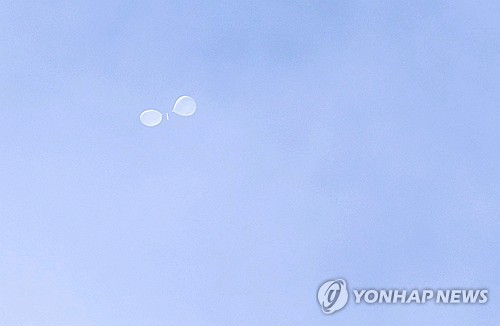- California Assembly OKs highest minimum wage in nation
- S. Korea unveils first graphic cigarette warnings
- US joins with South Korea, Japan in bid to deter North Korea
- LPGA golfer Chun In-gee finally back in action
- S. Korea won’t be top seed in final World Cup qualification round
- US men’s soccer misses 2nd straight Olympics
- US back on track in qualifying with 4-0 win over Guatemala
- High-intensity workout injuries spawn cottage industry
- CDC expands range of Zika mosquitoes into parts of Northeast
- Who knew? ‘The Walking Dead’ is helping families connect
N. Korea sends some 300 trash-carrying balloons into S. Korea: JCS
North Korea again launched hundreds of trash-carrying balloons toward South Korea on Wednesday, the Joint Chiefs of Staff (JCS) said, with some pieces of garbage landing on the presidential office compound in Seoul.
The launch, which marked the second of its kind this week, came as the South Korean military blared anti-Pyongyang broadcasts in full-scale through its border loudspeakers for the fourth day in response to the North’s continued launches.
Earlier in the day, the Presidential Security Service discovered fallen trash on the grounds of the complex in central Seoul, as North Korea sent more balloons carrying pieces of scrap paper and other trash.
An analysis of the fallen objects showed they did not present a danger. But the military has refrained from shooting down the balloons out of concern their contents could spread further and cause more damage.

The JCS said it has detected around 300 balloons as of 4 p.m., with the number expected to rise as additional balloons are floating in midair.
Some 250 balloons have fallen mostly in Seoul and the northern area of nearby Gyeonggi Province, the JCS said.
Landings and takeoffs were suspended at Gimpo International Airport in western Seoul at one point due to balloons presumed to be from the North.
Flights were prohibited from landing at or taking off from the airport for about an hour until 6:11 p.m. due to “three unidentified balloons” presumed to be from North Korea, the airport operator said, adding that the incident caused only minor delays to flight schedules.
North Korea has launched more than 3,000 trash-carrying balloons since late May, including some 500 such balloons Sunday, in a tit-for-tat move against anti-Pyongyang leaflets sent by North Korean defectors and activists in the South.
In response, South Korea has resumed full-scale propaganda loudspeaker broadcasts toward the North.
Since Sunday, the military has been conducting daily loudspeaker broadcasts on all the fronts across the roughly 250 kilometer-long inter-Korean border.
The military briefly conducted the broadcasts on June 9 for the first time in six years before turning them off in an apparent bid to prevent the situation from spiraling out of control.
It partly restarted daily loudspeaker operations last week in response to Pyongyang’s balloon campaign.
Meanwhile, North Korea began broadcasting crackling sounds through its border loudspeakers on Saturday, according to the military official.
The military suspects the noise could be intended to prevent North Koreans in the border area from listening to the South’s broadcasts, the official said, adding that it is likely to have a limited effect.
“From the North’s side, our loudspeaker broadcasts and their speaker noise will likely be heard together,” the official said.
North Korea has bristled against the loudspeaker campaign, as well as anti-Pyongyang leaflets sent by South Korean activists, on fears that an influx of outside information could pose a threat to the Kim Jong-un regime.
Last week, Kim Yo-jong, the powerful sister of the North’s leader, warned of “gruesome and dear” consequences over continued leaflet campaigns.
In 2014, the two Koreas exchanged machine gun fire across the border after the North apparently tried to shoot down balloons carrying propaganda leaflets critical of North Korea.











